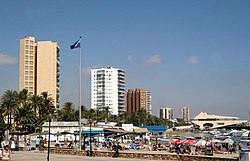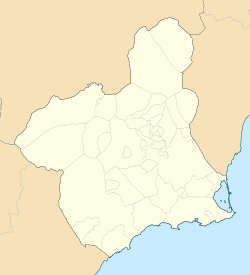San Javier, Murcia
You can helpexpand this article with text translated fromthe corresponding articlein Spanish.(June 2013)Click [show] for important translation instructions.
|
San Javier | |
|---|---|
 | |
 Location in Murcia | |
| Coordinates:37°48′13″N0°50′3″W/ 37.80361°N 0.83417°W | |
| Country | |
| Autonomous Community | |
| Province | |
| Comarca | Comarca del Mar Menor |
| Government | |
| • Mayor | Juan Martínez Pastor (PP) |
| Area | |
| • Total | 74 km2(29 sq mi) |
| Elevation (AMSL) | 4 m (13 ft) |
| Population (2018)[1] | |
| • Total | 31,905 |
| • Density | 430/km2(1,100/sq mi) |
| Time zone | UTC+1(CET) |
| • Summer (DST) | UTC+2(CEST (GMT +2)) |
| Postal code | 30730 |
| Area code | +34(Spain) + 968 (Murcia) |
| Website | Official website |
San Javier(Spanish pronunciation:[saŋxaˈβjeɾ]) is a small town andmunicipalityin theautonomous community and province of Murciain southeasternSpain.The municipality is situated at the northern end of Murcia'sMediterraneancoastline, theCosta Cálida.
History
[edit]There is little trace in the historical and archaeological record of early human habitation in the municipality itself. There is, however, evidence of prehistoric human presence at several nearby locations, including Cabezo Gordo hill inTorre-Pachecoand the salty coastal lagoon, theMar Menor.[2]
San Javier was prized for its climate inRoman Hispania,and for the Mar Menor, where asalt industrydeveloped. Traces ofRomanandCarthaginianpresence remain. A major Roman road, theVia Augusta,passes through the area and there are several underwater sites where, among other artefacts, pots and amphorae have been found.[3]
InAl-Andalus,duringIslamic rulein theIberian Peninsula,while there was little Arab or Berber presence in the territory of the current municipality there is evidence of use of their fishing technology, known in Spanish asencañizada.Muslim presence is also attested in nearbyLos Alcázares,where walls and cisterns from this period remain.[4]
WhenKing Alfonso X of Castileconquered thetaifaof Murcia, the coastal area was only sparsely occupied, by shepherds and fishermen.
TheHuerta de Murciaand Mar Menor regions were gradually repopulated between the 13th and 16th centuries. Some of the families obtaining property near the Mar Menor took their surnames from the local area: Lo de Tacón, Saavedra, Roda, Galtero y Aledo. New churches and chapels were built as new population centres developed. At the beginning of the 18th century, one of these small churches founded the hamlet of San Javier.[4]
By 1809, the population of the villages of San Javier, Roda and La Calavera was 428.[5]
During the three years of theTrienio Liberal(1820–1823), a number of town councils were established in the Huerta de Murcia and Mar Menor regions. One of these was in San Javier. When this period ended, the town council of San Javier was abolished and the area once again became a district of the municipality of Murcia. The San Javier town council was reinstated in 1836.[5]
Over the last 30 years of the 19th century, economic hardship and poverty in the municipality led inhabitants to migrate to find work as farmhands and miners, inLa Uniónin Murcia andOranin Algeria. At the close of the 19th century the area had 3,770 inhabitants, of whom half were farmers and the remainder fishermen and artisans.[5]
Some families prospered despite local poverty, becoming wealthy through dealings in land. A new middle class of administrators of country estates, entrepreneurs, mine owners, moneylenders and farmers emerged.[5]
Settlement of the area known today as Santiago de la Ribera began in 1888.[5][6]
A Naval Flying School was founded in San Javier in 1932.[5]
In 1943, the San Javier General Air Force Academy (Academia General del Aire) was established, founding a new neighbourhood, Ciudad del Aire.[5]
Administrative divisions
[edit]The administrative perimeter of the municipality includes the town and ten smaller villages. Of these, the last two in the list are located on the coast:[7][8]
- El Mirador
- La Grajuela
- Roda
- Los Sáez de Tarquinales
- Pozo Aledo
- Los Pinos
- Lo Llerena
- La Calavera
- Santiago de la Ribera
- La Manga del Mar Menor
Climate
[edit]| Climate data for Murcia—San Javier (Airport 4 m, near sea) (1981–2010), extremes (1930–) | |||||||||||||
|---|---|---|---|---|---|---|---|---|---|---|---|---|---|
| Month | Jan | Feb | Mar | Apr | May | Jun | Jul | Aug | Sep | Oct | Nov | Dec | Year |
| Record high °C (°F) | 26.2 (79.2) |
27.8 (82.0) |
31.5 (88.7) |
32.0 (89.6) |
36.0 (96.8) |
36.9 (98.4) |
40.5 (104.9) |
40.0 (104.0) |
39.4 (102.9) |
35.5 (95.9) |
30.0 (86.0) |
27.0 (80.6) |
40.5 (104.9) |
| Mean daily maximum °C (°F) | 16.0 (60.8) |
16.7 (62.1) |
18.5 (65.3) |
20.4 (68.7) |
22.9 (73.2) |
26.4 (79.5) |
28.9 (84.0) |
29.5 (85.1) |
27.5 (81.5) |
24.0 (75.2) |
19.8 (67.6) |
17.6 (63.7) |
22.3 (72.1) |
| Daily mean °C (°F) | 10.8 (51.4) |
11.6 (52.9) |
13.4 (56.1) |
15.3 (59.5) |
18.4 (65.1) |
22.2 (72.0) |
24.8 (76.6) |
25.5 (77.9) |
23.2 (73.8) |
19.4 (66.9) |
14.9 (58.8) |
11.9 (53.4) |
17.6 (63.7) |
| Mean daily minimum °C (°F) | 5.5 (41.9) |
6.5 (43.7) |
8.4 (47.1) |
10.2 (50.4) |
13.8 (56.8) |
17.9 (64.2) |
20.7 (69.3) |
21.5 (70.7) |
18.9 (66.0) |
14.7 (58.5) |
10.0 (50.0) |
6.8 (44.2) |
12.9 (55.2) |
| Record low °C (°F) | −3.8 (25.2) |
−4.0 (24.8) |
−3.0 (26.6) |
1.0 (33.8) |
4.8 (40.6) |
9.5 (49.1) |
11.0 (51.8) |
12.0 (53.6) |
7.9 (46.2) |
4.0 (39.2) |
−1.5 (29.3) |
−5.4 (22.3) |
−5.4 (22.3) |
| Averageprecipitationmm (inches) | 42 (1.7) |
27 (1.1) |
24 (0.9) |
23 (0.9) |
25 (1.0) |
7 (0.3) |
2 (0.1) |
7 (0.3) |
39 (1.5) |
39 (1.5) |
47 (1.9) |
30 (1.2) |
313 (12.3) |
| Average precipitation days(≥ 1 mm) | 4 | 3 | 3 | 3 | 3 | 1 | 0 | 1 | 3 | 4 | 4 | 4 | 33 |
| Mean monthlysunshine hours | 173 | 171 | 206 | 224 | 266 | 288 | 307 | 283 | 224 | 200 | 162 | 156 | 2,621 |
| Source:Agencia Estatal de Meteorología[9][10] | |||||||||||||
Aerodrome
[edit]Amilitary aerodromewas built in Santiago de la Ribera before theSpanish Civil War.Its Bomber School (Escuela de Vuelo de Alta Velocidad) and Multi-Engine Aircraft School(Escuela de polimotores)were used by theSpanish Republican Air Forceto train militarypilots.[11]
After the Civil War, the airfield was used by theSpanish Air Forceas an occasional landing facility. Currently it is the location ofMurcia–San Javier Airport,which was to August 2018 the largest in the Region of Murcia.[12]
Notable people
[edit]- Antonio Cañadas,footballer
See also
[edit]References
[edit]- ^Municipal Register of Spain 2018.National Statistics Institute.
- ^"Historia de San Javier- Prehistoria - Región de Murcia Digital"(in Spanish).Retrieved2017-09-17.
- ^"Historia de San Javier- Antigüedad - Región de Murcia Digital"(in Spanish).Retrieved2017-09-17.
- ^ab"Historia de San Javier - Edad Media - Región de Murcia Digital"(in Spanish).Retrieved2018-09-17.
- ^abcdefg"Historia San Javier - Edad Contemporánea - Región de Murcia Digital"(in Spanish).Retrieved2018-09-17.
- ^"Ayuntamiento de San Javier"(in Spanish).Retrieved2018-09-17.
- ^"Las pedanías".sanjavier.es(in Spanish).Retrieved2018-07-14.
- ^"Pedanías de San Javier - Región de Murcia Digital".regmurcia(in Spanish).Retrieved2018-07-14.
- ^"Normals San Javier Aeropuerto".AEMET.Retrieved21 February2021.
- ^"Extremes for San Javier Aeropuerto".AEMET.Retrieved21 February2021.
- ^Memoria republicana — SBHAC. Estructura orgánica de las FARE
- ^Ejército del Aire - Academia General del Aire (AGA)Archived2015-02-01 at theWayback Machine




